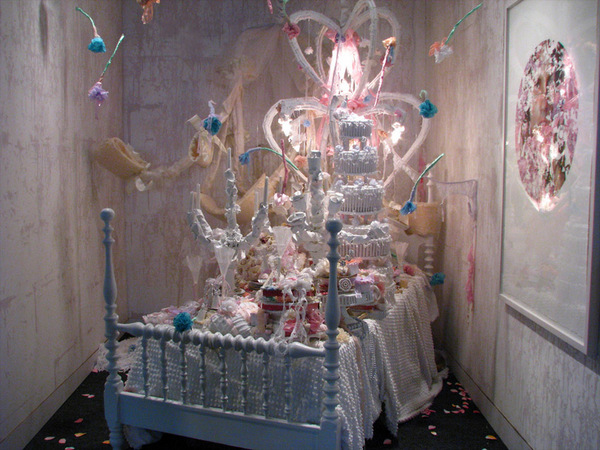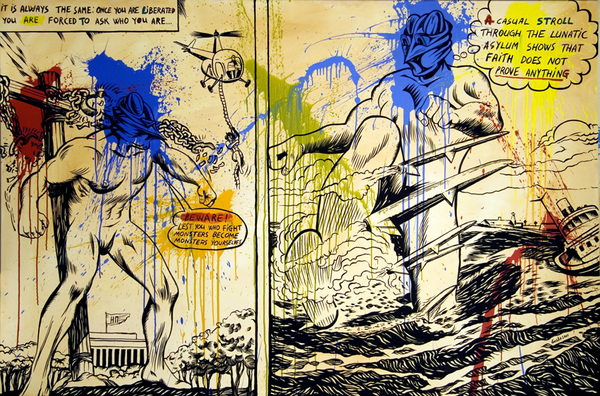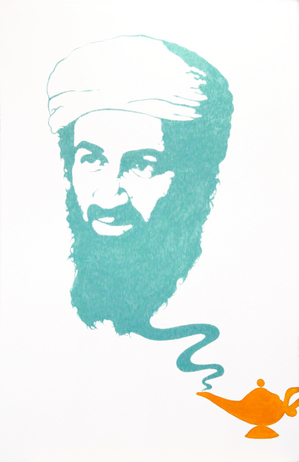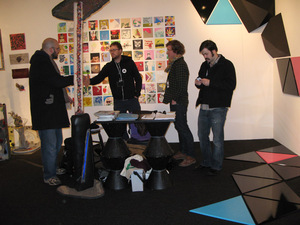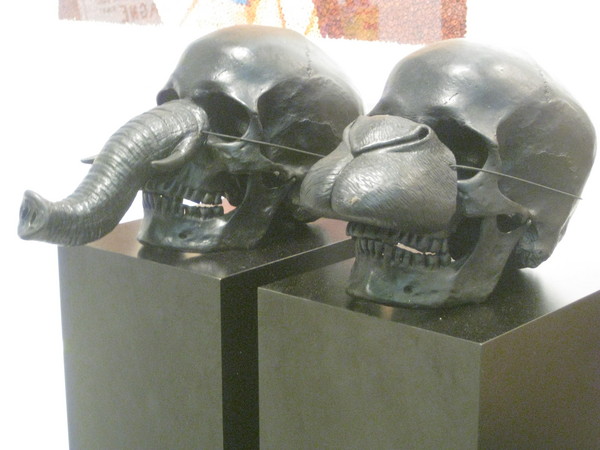This is an archive of the ArtCat Zine, 2007-2009. Please visit our new project, IDIOM.
Fairs Archive
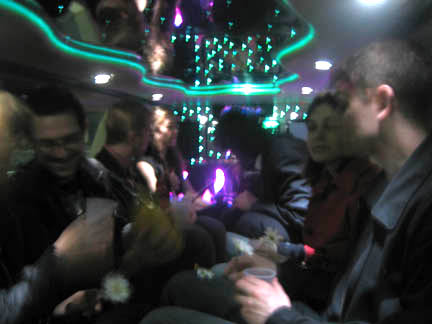
On the last day of this year’s Armory Show, a friend and I made our way out to 12th avenue and climbed into the back of a limo. Joining us were several other people, a host from Art International Radio, a woman playing a toy piano, a man playing a violin, a composer, several bottles of champagne, and the co-curator of the event, Sonya Hofer. We took off down the West Side Highway as the composer handed out postcards displaying various abstract ink drawings.
“Hand them to the musicians and they will play what’s on the card,” he explained. There was a pause before someone turned over a card featuring an image of a cat and a dog. The woman playing the piano immediately launched into a vigorous composition. The violin followed suit. Champagne was poured. “So,” said the host, “what is your favorite thing in the world?”
“Art!” offered somebody, another preferred love, still another made a case for music. A discussion ensued as the limo turned left and the violinist began to make little barking noises. “And the worst thing?” the host piqued, pouring another round; hate, abuse, disappointing someone, and getting up in the morning, came the replies. The violinist was really yelping now, and the woman at the piano looked pleadingly at the passengers. “I suggest,” said the composer, an elegant man in shoulder length hair, small glasses and a stylishly rumpled suit, “that you hand them another card.” A general dawning spread throughout the cabin and several cards were quickly thrust forward. A star pattern prompted a shift to a sprinkling etude as the violinist indicted his gratitude.
The limo was somewhat cramped, as such vehicles always are, but a third round of champagne seemed to affect a general loosening: a husband sitting across from us confessed his wedding day to have been the best of his life. His wife, sitting next to him, spoke subsequently but chose differently, “Sorry, darling,” she said, to laughter. Some twenty minutes and three bottles later we were all of us back on the pier, somewhat tipsy, tilting our separate ways. A passenger pumped Hofer’s hand, “Wonderful, just wonderful” she beamed, before skipping back inside towards the fair.
I used to think of Pulse as the hip, younger cousin to the Armory, the one who you feel weird about admitting any familial relations. Now I think it's more like the rich aunt: very kind, generous, always perfectly put together, but a bit cold and aloof. In no way is this a judgment on the art or the presented projects but just a general overview of the scene. In fact, as far as art viewing and the constraints of space go, Pulse does not disappoint. Nearly every booth is straight up curated and perfectly contained, using just the right wall-space-to-art-work ratio, while presenting works on paper, canvases, photographs, installations, video, and even performance. Much like the general air of a slightly defeated, somewhat despondent, but mostly just optimistically reinvigorated air of New York City in the wake of our oft-discussed economic gutter, creative energy abounds. Gallerists are friendlier, perhaps knowing that while uber-success may not be in the cards, exposure and zealous curiosity is still the underpinning that draws the bulk of the spectating hordes. Don't get me wrong: tight-faced, bedazzled ladies still make their appearance but perhaps less so at Pulse this year.
DCKT Contemporary's presents a meticulously curated show of work by Cordy Ryman -- whose small abstract paintings, sculptures and installations use a variety of material to poke fun at the contrivances of visual language while exploring the nuances of "artistic" versus everyday material. Prague's Vernon Galerie shows a very complicated project by Jakub Nepras that, while intensely gripping, was too complicated for my short attention span. The gallery brought an impressive array of work. Like an Olympic triumph, Pulse victoriously passes the torch by showcasing galleries from distant lands, including notables Chi-Wen Gallery from Taipei, Space from Bratislava, Habana from Havana City and Silver Lens Gallery from Manila. Adding to the fun are the numerous installations, as part of the Pulse Installations series, for which individuals artists were commissioned to do a slew of diverse work, in case viewing art in contained booths is simply not your thing. Clifton Childree's hilarious abandoned tropical shack titled Miamuh Swamp Adventure, is a dilapidated construction that viewers enter to find a slapstick silent film about Miami real estate scams from the turn of the century -- a perfect piece during which to take a break, check your email or make out. Laure Prouvost's Close your eyes, you are the only one is a sound piece that serenades you with spam and chain mail. Miriam Cabessa meanwhile spent hours painting her performance piece Slow Motion Action Painting, which admittedly lacked in action but delivered on the "slow."
The little Hegel is all of us is tempted to dismiss pop art. It may no longer be revolutionary to appropriate commercial imagery and style into visual art, but Volta’s booths proved it still has some mileage left.
Now in its true late style, we are well aware of the strengths and -- perhaps more importantly -- the limits of Pop. Indeed, the willingness to explore and harness its weakness is precisely what sweetens these late chapters. That content, light and fluffy as cotton candy, and with half the substance, can surely backfire into the meaninglessness of elevator music or small talk. But this idea of backfire is now the point. A Pop style can visually indict its subject as a pleasant lie or polite fiction that conceals an inconvenient truth.
The paintings of Shen Jingdong at the stand of New York’s China Square gallery attack the fiction of the content army and the happy family. Casting these social ideals as smiling children’s toys reminds us that it’s a juvenile over-simplification to think in such saccharin terms: bringing up teenagers is practically masochistic for any parent and memories of combat haunt even the toughest veterans. As sparkles of light dance on new plastic, Shen Jingdon proves that not all that glitters is gold.
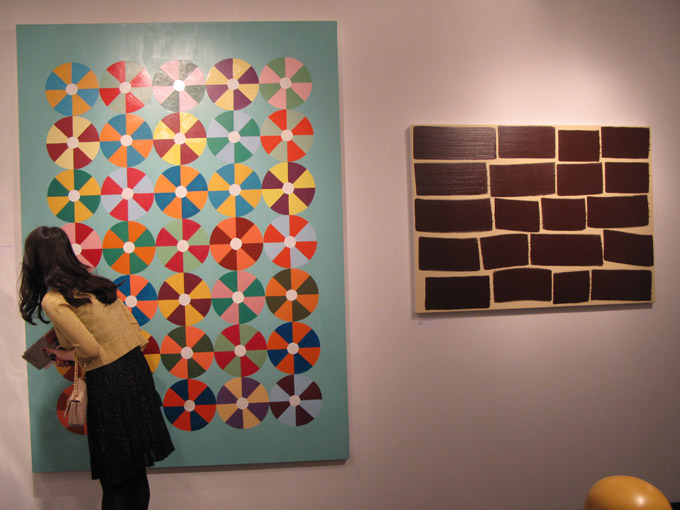
I can still remember the glorious days of yore (2004) when Scope was held at the not-yet-opened-but-with-a-pool Gansevoort Hotel. as the Meatpacking was quickly becoming the glorious "bridge and tunnel" cesspool, coinciding with Samantha Jones' move to the neighborhood and its quick and structural demise.The dark and swanky hotel rooms, the copious Kettle One everwhere and those frozen tubes of neon corn syrup they peddle in the local bodegas -- except this time melted and intended for use as mixers: it's a memory of sensation. Alas, Scope has changed -- neigh, revolutionized, in many ways. The air of disorganized merriment notwithstanding, the fair is now a whole new animal.
Tightly wedged between Fordham Law and Lincoln Center, Scope's highbrow neighbors are an apt consortium for the fair's presence. Scope now fills a chorus line of tents that give way before giving way to a harmonious range of galleries, individual artist projects and other sundry exhibitors. A number of notable galleries quickly draw you into their strongholds, either with great art or free wine. Let's face it, a great and timeless match that I can and will not refuse. (Huevos rancheros?) Glass and camera in hand, I immediately noticed the charming folks of Okay Mountain, an artist run gallery from Austin. Exhibiting their own collective work as well as other artists from the gallery, they had a visual cornucopia of sculpture, digital prints, works on paper, various large multi-media pieces and a friendly disposition. Further along and part of the special artists' projects that the Scope Foundation has commissioned is Comenius Roethlisberger and Admir Jahic's Without You Babe, There Ain't No Us, originally shown at Scope Miami just a few months prior. A series of works on paper utterly preoccupied with YouTube, Without You Babe... offers an antidote to the tendancy for art as a pixelated screen grab. The artists render their obsessively over-watched favorite moments with the soft markings of colored pencils, streaming online pop culture videos into simple, contemplative scenes.
Before you even make it through the lobby of the 2009 Armory Show, the headlines of The Art Newspaper – one of the rare items at the fair without a price tag attached – offer a clear indication of the year’s underlying theme. “New Pier 92: Art of the Depression… the 1930s, that is;” “Financial Situation Forces Gallery Withdrawals;” and finally, the lead story grins through clenched teeth: “Economic Downturn Prompts Stand-Out Booths.” In recent months, the art world has been hit particularly hard by the global recession, a downturn that has reversed trends of blank check opulence and rendered Damien Hirst-style momemto mori itself momento mori. Galleries are scaling back, and as Holland Cotter declared last month in The New York Times, it’s “day-job time again [for artists] in America.” But in spite of looming fears and shrinking wallets, this year’s Armory Show moves valiantly forward and strives to distinguish itself in its refusal to cut corners. While last year’s fair registered a record 50,000 attendees, it’s obvious the curators now hope to exceed that number, incorporating an extra pier into the Armory’s already labyrinthine layout and increasing the show’s size by an additional 50%.
After a week of intensive art fair coverage on our parallel fair blog, we're pleased to post Brent Burket's scattershot impressions of The Armory Show. An excerpt follows:
I always pay attention when I'm unusually hungry for a certain piece of music. It always reveals a little bit about where my head and heart are residing in a given moment. Crossing 9th Avenue on my way to the Armory I was overcome by the desire to listen to the biggest and dumbest song I could find on my iPod, Fish's live version of The Heart of Lothian. Turned out that having the barrel-chested Scotsman in my ears was a perfect way to prepare for the annual goofy-ass grandness of the Armory. Onward!
ZINE
HOME
TIPS / COMMENTS
CATEGORIES
CONTRIBUTORS
- Greg Afinogenov
- B. Blagojevic
- Adda Birnir
- Susannah Edelbaum
- Julie Fishkin
- Paddy Johnson
- Jessica Loudis
- Christopher Reiger
- Andrew Robinson
- Peter J. Russo
- Blythe Sheldon
- S.C.Squibb
- Hrag Vartanian

